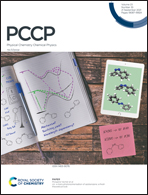ReaxFF-MPNN machine learning potential: a combination of reactive force field and message passing neural networks†
Abstract
Reactive force field (ReaxFF) is a powerful computational tool for exploring material properties. In this work, we proposed an enhanced reactive force field model, which uses message passing neural networks (MPNN) to compute the bond order and bond energies. MPNN are a variation of graph neural networks (GNN), which are derived from graph theory. In MPNN or GNN, molecular structures are treated as a graph and atoms and chemical bonds are represented by nodes and edges. The edge states correspond to the bond order in ReaxFF and are updated by message functions according to the message passing algorithms. The results are very encouraging; the investigation of the potential, such as the potential energy surface, reaction energies and equation of state, are greatly improved by this simple improvement. The new potential model, called reactive force field with message passing neural networks (ReaxFF-MPNN), is provided as an interface in an atomic simulation environment (ASE) with which the original ReaxFF and ReaxFF-MPNN potential models can do MD simulations and geometry optimizations within the ASE. Furthermore, machine learning, based on an active learning algorithm and gradient optimizer, is designed to train the model. We found that the active learning machine not only saves the manual work to collect the training data but is also much more effective than the general optimizer.



 Please wait while we load your content...
Please wait while we load your content...